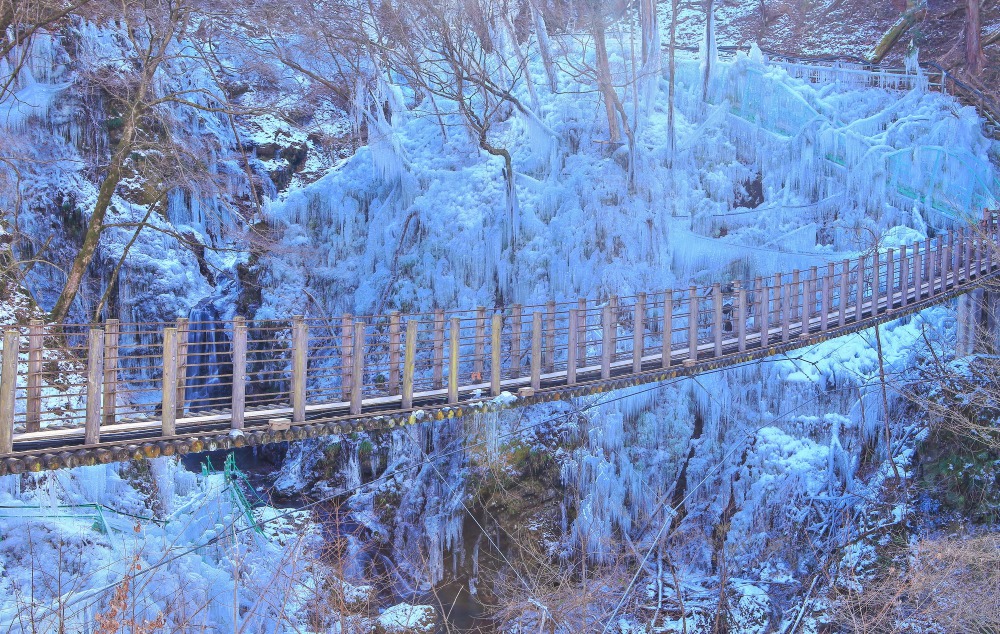The four seasons are very distinct in Japan, and each has their own seasonal sights. Winter is a great time to visit Japan for a snowy, icy scenic tour. Here, we will introduce 5 spots in the Kanto region that you will want to visit this winter: Fukuroda Falls in Ibaraki, Izuruhara Benten Pond and Kegon Falls in Tochigi and Misotsuchi and Onouchi Hyakkei Icicles in Saitama.
1. Fukuroda Falls (Ibaraki)

Fukuroda Falls
Sights to see
Fukuroda Falls is chosen as one of Japan’s three major waterfalls, and locates in Ibaraki prefecture just north of Tokyo. In the winter months, the falls freeze completely. The sight of the 120-meter tall, 73-meter wide waterfall that has frozen completely is stunning and impactful.
The falls are beautiful year-round. In fact, the famous Heian Period (794-1185) poet Saigyo recommended one to visit the falls every season to enjoy all of its sights.
How much of the falls freeze varies by year. If the temperature isn’t low enough, the falls may not freeze completely. It is quite rare to see the falls completely frozen, so consider yourself lucky if you do!

Fukuroda Falls light-up event
Between November and January, a special light-up event is held at Fukuroda Falls. The falls and the nearby suspension bridge are lit up with colorful LED lights, and creates a dream-like atmosphere.
Information
Event period: November 1, 2019 (Fri.) to January 31, 2020 (Fri.)
Light-up hours: Sunset to 8:00p.m. (Nov.) and Sunset to 7:00p.m. (Dec. and Jan.)
Fees: ¥300 for adults, ¥150 for children
2. Izuruhara Benten Pond (Tochigi)

Izuruhara Benten Pond
Sights to see
Izuruhara Benten Pond, in Tochigi prefecture’s city of Sano, is a prefecture natural monument. The pond is a spring, which has been designated as one of Japan’s 100 spring waters.
The pond’s waters are strikingly clear. The waters are well maintained by the city’s organizations and volunteer groups.
Throughout the year, the water temperature is around 16 degrees Celsius. The water is used to raise fish, and the water from the lower area of the spring is used for irrigation.
Izuruhara Benten Pond’s waters are filtered through a limestone stratum, resulting in a high level of calcium hydrogencarbonate. The water is drinkable, and has a soft taste to it.
You can taste the water at the nearby ryokan inn, Hotel Ichinokan.
3. Misotsuchi Icicles (Saitama)

Misotsuchi Icicles
Sights to see
Misotsuchi Icicles can be found in Chichibu, Saitama. These icicles are created naturally, from water dripping from rocks. They vary in size, and can get as large as 10 meters in length and 50 meters in width.
You can find the icicles at two locations: Woodroof Okuchichibu Auto Camp Grounds or Tsuchiuchi Camp Grounds.

Misotsuchi Icicles light-up event
From January to mid-February, a light-up event is held at Misotsuchi Icicles. There are 36 different light-up designs in total that illuminate the icicles. With the lit-up icicles reflecting on the adjacent river, the event brings about an ethereal vibe.
During the event, there are food stalls at the Woodroof Okuchichibu Auto Camp Grounds. These stalls sell local foods, amazake and more.
Misotsuchi Icicles have been introduced on television and are a popular winter destinations. It can get crowded on weekends and on public holidays, resulting in over an hour wait for the parking lot. Also, make sure to dress warm, since winter in Chichibu is very cold.
Information
Event period: January to mid-February
Light-up hours: 5:00p.m. to 7:00p.m. (9:00p.m. on weekends and public holidays)
Food stalls and tourism center: January between 10:00a.m. and 3:00p.m.
4. Onouchi Hyakkei Icicles (Saitama)

Onouchi Hyakkei Icicles
Sights to see
In the town of Ogano, you can find Onouchi Valley. In the winter, the valley freezes up and icicles are created all around. Enjoy the view of the icicles from the suspension bridge.
The icicles are man-made, with the waters pulled from the waters from Mount Ryokami via a 500-meter long pipe. They are made around the walking path and the suspension bridge. The view from the viewing platform is breathtaking.
Usually, the walking path is accessible by crossing the suspension bridge. However, during the winter months, the walking path is closed off. Though the suspension bridge is made sturdily, you can still feel it shake as you walk. As you walk across the bridge, you will get closer and closer to the icicles.

Onouchi Hyakkei Icicles Light-up
The light-up event at Onouchi Hyakkei Icicles is only held five times. The view of the lit-up icicles and suspension bridge is magnificent.
Information
Event period: January to late February
Event time: 8:00a.m. to 4:00p.m.
Services: Free local specialties such as amazake and hand-made pickled vegetables
Fee:¥200 (junior high school students and above)
5. Kegon Falls (Tochigi)

Kegon Falls
Kegon Falls, in Tochigi’s city of Nikko, is one of Japan’s three major waterfalls, along with Fukuroda Falls and Nachi Falls. The water falls from 97 meters above the ground.
There is a viewing platform that can be accessed via elevator. From there, you can see the fall basin up close and hear the thundering sounds of the water hitting the ground.

Kegon Falls’ Blue Ice
In the winter months (January and February), the about 12 smaller waterfalls surround Kegon Falls completely freeze. This phenomenon is called “blue ice”.
Kegon Falls is stunning throughout the year. Its scenery in the autumn, with the colorful fall leaves, is especially worth another visit.
Perfect for a winter day trip
These five spots are all located fairly close to Tokyo, making them great day-trip destinations. Enjoy these sights when visiting the Kanto region during the winter months!













_600x400.jpg)














_600x400.jpg)


